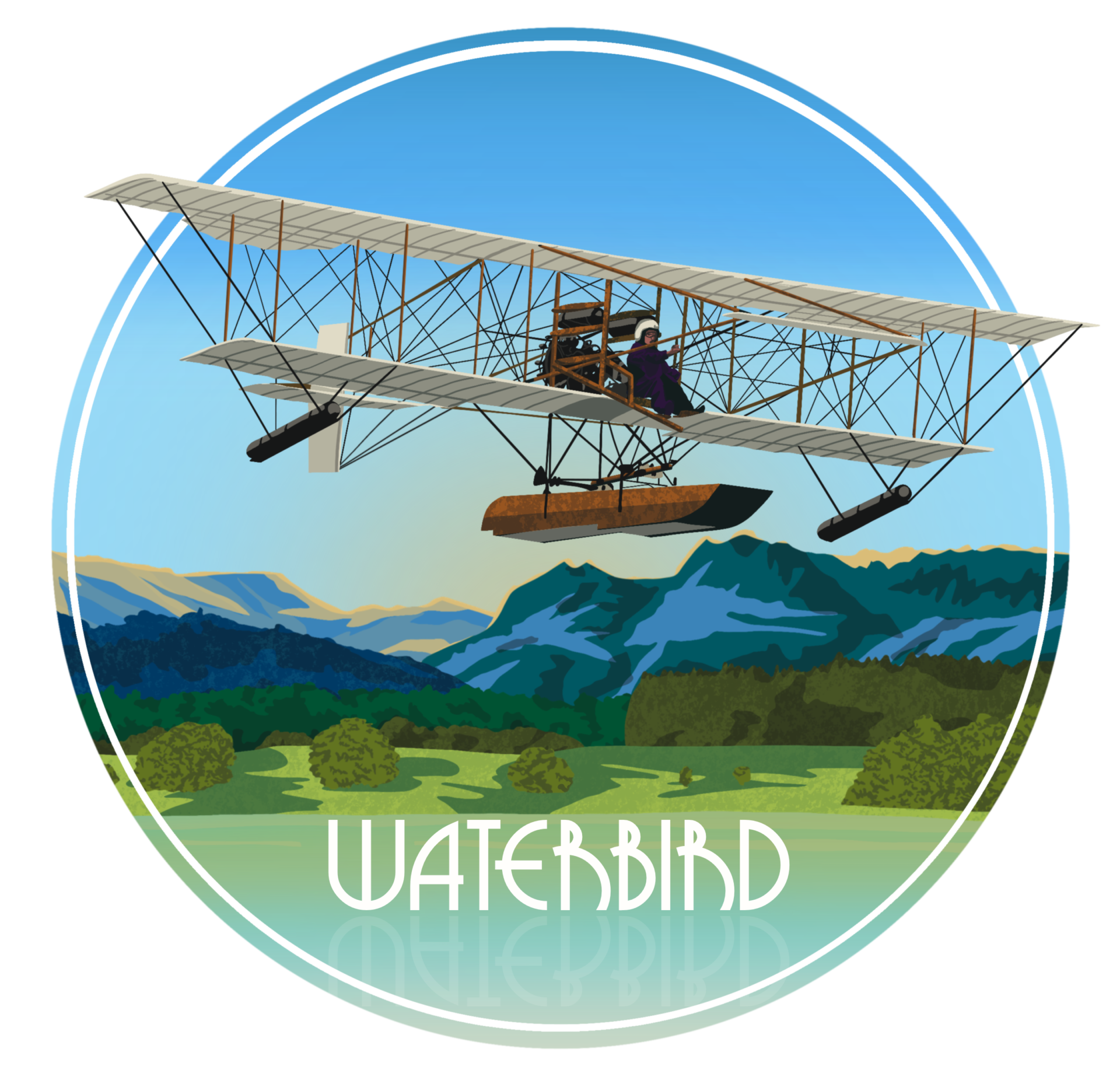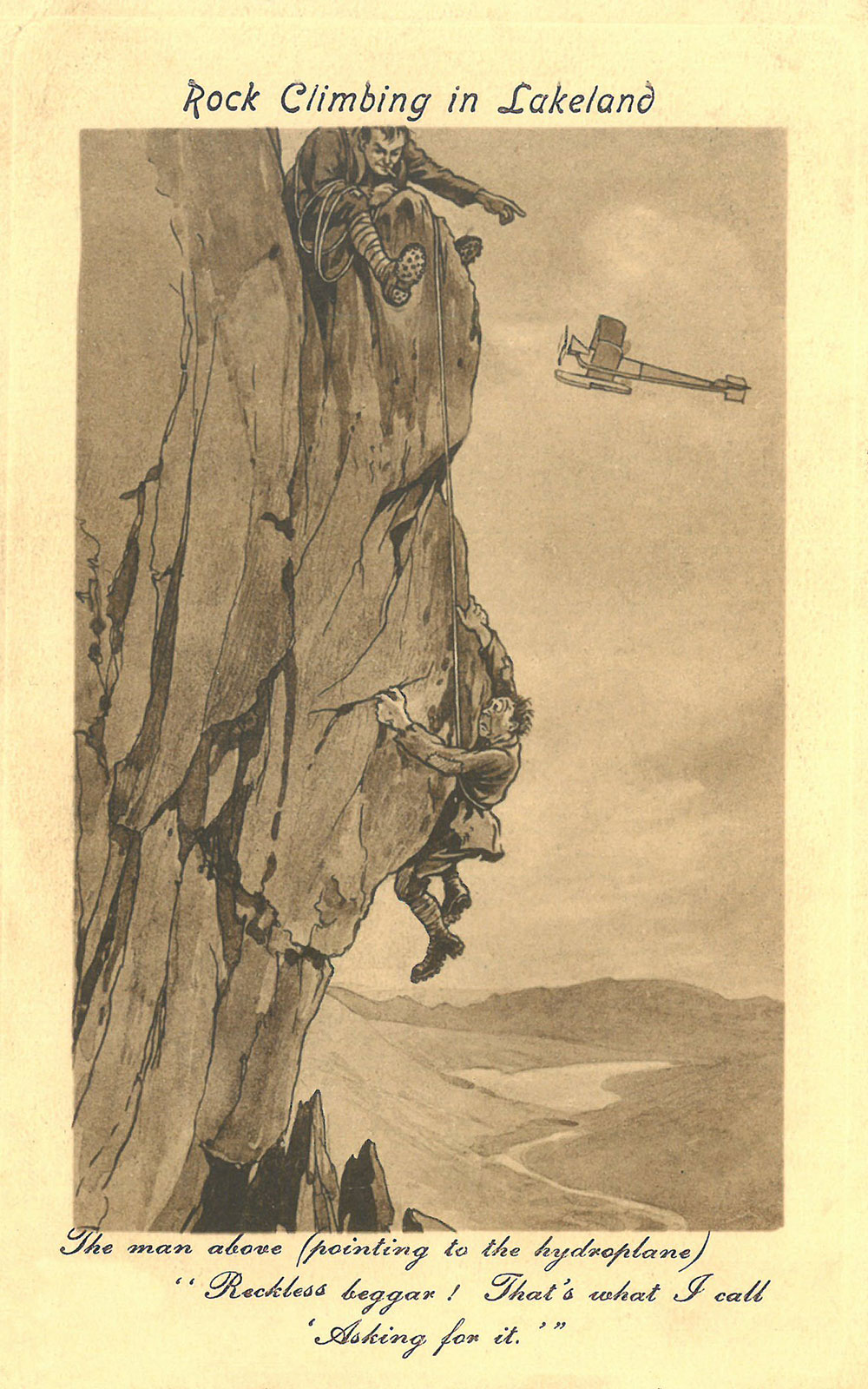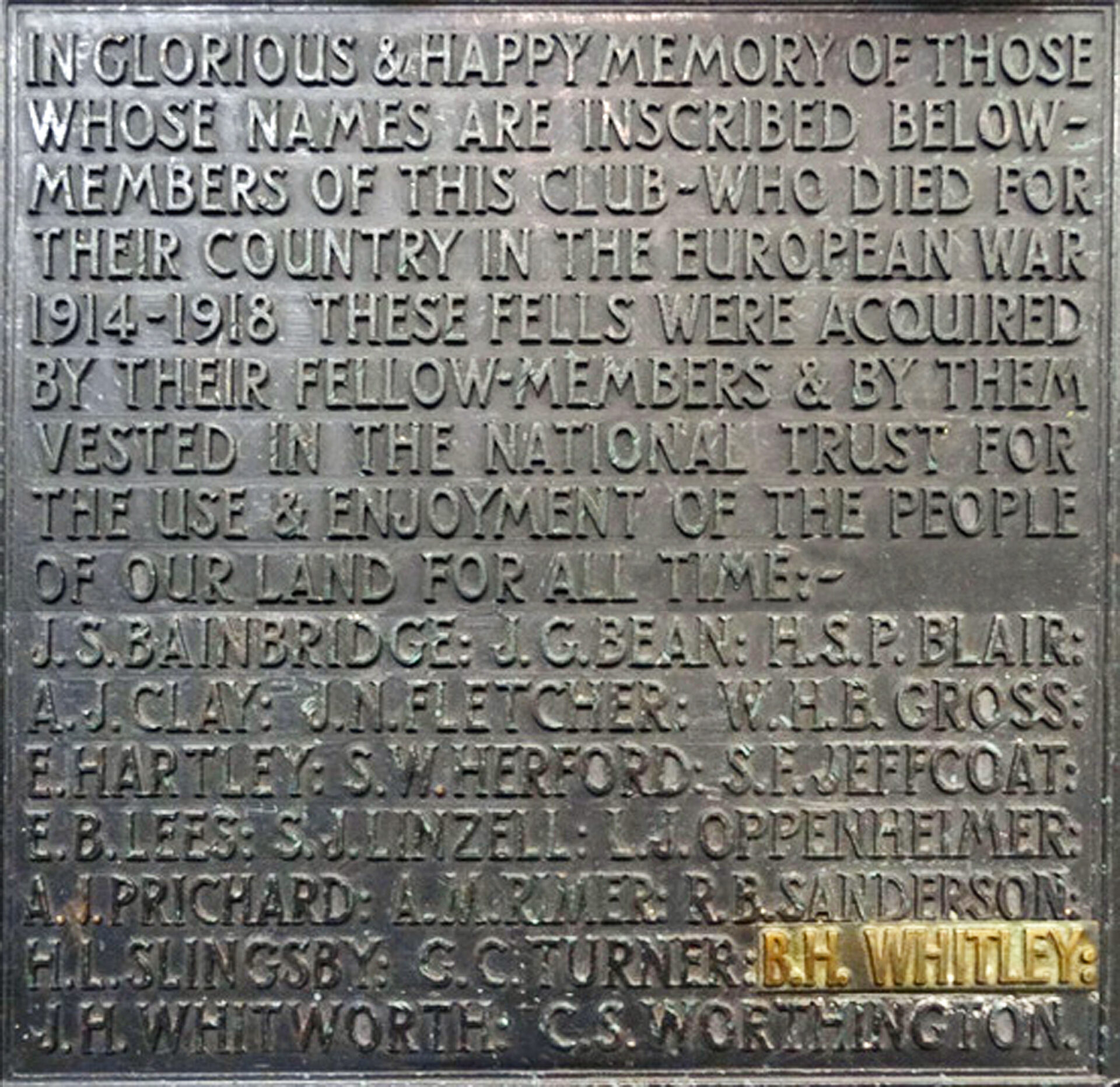Captain Arthur William Wakefield, MA, MD, BCh, MRCS, MRCP
(1876 – 1949)
Dr. Arthur Wakefield (known as Waker) was the youngest brother of Captain Edward Wakefield who commissioned the hydro-aeroplane Waterbird. Wakefield served in the Newfoundland Regiment and then the Royal Army Medical Corps as a surgeon throughout World War 1, including attached to the 29th Casualty Clearing Station at Gézaincourt, the Somme from the last days of 1915 to 12 October 1916, and was Mentioned in Despatches in 1917. Also, he was in charge of building the Acheux train line which transported wounded from the front lines to his Station. He acted as medical officer and was a climber on the 1922 Mount Everest expedition, which included George Mallory. He was President of the Fell and Rock Climbing Club 1923-25 and the Club’s first life member.
– Edward Wakefield gave the reason for flight from water as “Something that beckoned”. Along the lines of Mallory’s reason for climbing Everest of “Because it’s there”.
Having reached the North Col of Everest at 23,000 feet, Wakefield wrote in his diary that he planned an ascent on 28 May 1922. However, with all the fuel being used up in the camp during the night and having overdosed his colleague Colin Crawford with morphine so as to be too sleepy, they had to descend. The food then available comprised a tin of Bovril, a small loaf of parkin, a little Kendal Mint Cake and a few raisins and figs.
At the first Winter Olympics at Chamonix in 1924 the Everest team were each awarded a gold medal, with the citation ‘the greatest feat of alpinism in the preceding four years’. Edward Strutt, Deputy Leader of the expedition, promised when accepting the medals that he would take one to the top of Everest but did not manage to do so. Fulfilling that pledge 88 years later, in May 2012 Wakefield’s medal was taken to the summit by Kenton Cool.
THE FELL AND ROCK CLIMBING CLUB OF THE ENGLISH LAKE DISTRICT
As President of the Fell and Rock Climbing Club (‘FRCC’), Wakefield handed over the title deeds of land totalling 1,184 acres, which had been purchased by the FRRC’s members, to the National Trust. The presentation took place during the FRCC’s annual dinner at the Sun Hotel, Coniston on 13 October 1923. The land is above 1,500 feet (450 metres), in groups north and south of Styhead Pass. The more southerly group is comprised of Lingmell, Broad Crag, Great End, Seathwaite Fell, Allen Crags and Glaramara. The northern group contains Kirk Fell, Great Gable, Green Gable, Brandreth, Grey Notts and Base Brown.
‘At that time it was thought the gift covered about three thousand acres, but in 1944 when the National Trust bought Seathwaite Farm the curious fact emerged that apparently some of the land believed to be freehold was actually part of Borrowdale Common. … legally the freehold given by the Club now appears to consist of 1184 acres instead of 3000.’ – The Lake District and The National Trust by B Thompson. The 1,184 acres is confirmed by the National Trust Land Map.
Wakefield said “These deeds represent the lives of of our members with whom in many cases we have walked these fells. The cost is great. Never let us forget it”. – The Guardian, 15 October 1923.
‘If our friends died there is a corner of their dear land which will for ever bear witness to the memory of them, and of the work they did – “they have found an eternal monument among the everlasting hills”.’ – FRCC Journal, 1923.
The representative of the National Trust was Francis Acland MP, who expressed the hope that “the land might become the nucleus of a great national park in this part of the world”. – The Westmorland Gazette, 20 October 1923. The National Trust felt that the whole country owed a debt of gratitude and offered its sincere congratulations on the grandeur of the memorial. However, the Lake District National Park Authority was not formed until 1951.
On 18 March 1916, John Lankester Parker and Henry Reid flew to Coniston Water, secured the Blackburn seaplane to the steamer pier and walked to the Sun Hotel for lunch. This photo was taken upon their return to Windermere.
– This page respects the vision of those members of the Club involved.
MEMORIAL PLAQUE AT GREAT GABLE
On 8 June 1924, Wakefield unveiled a memorial plaque at Great Gable; the very day that Mallory and Sandy Irvine disappeared on Everest. As he began to speak, the grey mist and drifting rain cleared with sun breaking through the clouds. Geoffrey Winthrop Young, war veteran, poet, educator and mountaineer, who had recommended Wakefield as a candidate for the Everest expedition wrote ‘I saw him for a few moments again as he had been in his very vital and sunnily serene youth’.
The Reverend J H Smith said prayers of dedication. Young read a tribute, at Wakefield’s request – he had been invited to write it in verse, but every instinct told him to use prose. The hymns Lead, Kindly Light and Oh God, Our Help in Ages Past were sung and also the National Anthem. Godfrey Solly read Psalm 121. Herbert Cain read out the inscription on the plaque. The Last Post was sounded by 2 buglers of St Bees School Cadets.
The unveiling was extensively reported: Daily Mail, Evening Chronicle, Gazette Montreal, Guardian, Journal, Stockport Advertiser, Times, Westmorland Gazette, Wilmslow and Alderley and Knutsford Advertiser and Yorkshire Post.
‘About five hundred persons drew closer together as the President stood on the rock-platform next to the draped flag. [The flag was a war-stained White Ensign of the Royal Navy which flew from HMS Barham at the Battle of Jutland, loaned by Lieutenant Commander Charles Michaelson to whom it had been presented for accuracy in spotting the fall of shells.] Wakefield spoke slowly, under stress of the emotion everyone was feeling, of the climbers who had paid the last Great Sacrifice. He spoke of the love of freedom which had impelled them to dedicate strenuous hours to the joy of these hills, and to their love for their own land, which made its defence from incursion and domination a high and solemn duty. In a few words he described the great mountain park which lay in the mist and silence below and around, and which for memory, had been presented to the nation, a possession for ever.’ – William Palmer in the FRCC’s Journal.
It was a source of joy and pride to Wakefield that his Presidency coincided with the dedication. The obituary in the FRCC’s Journal described him as ‘One of the most outstanding, best loved and greatly distinguished members’. – Ashley Abraham.
The plaque was inscribed with the names of the 20 members of the FRCC killed in the European War 1914-1918. Half are either individually commemorated or buried in England – on this page, there are links to photos of all the plaques and headstones. 4 have no known grave and are commemorated in France. Their ages ranged from 23 to 48. Photos in France is work-in-progress!
Gallantry Awards to the 20 included 2 Distinguished Service Orders and 1 Bar [next in precedence after the Victoria Cross for gallantry in action], and 4 Military Crosses. Also, 9 Mentioned in Despatches 3 of which were to a single recipient and 1 Croix de Guerre.
Amongst the names on the plaque is that of ‘S. W. Herford’. ♱ Private Siegfried Wedgwood Herford is far left in this photo. He was killed near Bethune on 28 January 1916, aged 24, buried at Festubert and commemorated by a window at Eskdale Green Forgetting those things which are behind & reaching forth unto those things which are before. Press towards the mark. And I will lift up mine eyes unto the hills from whence cometh my help. Herford was awarded a research scholarship for an MSc degree on engine design at the Royal Aircraft Factory, Farnborough in 1913-1914. Young wrote ‘Siegfried was for us – besides being himself – the greatest rock climbing figure perhaps of all time: in his life already a tradition’.
W G Collingwood designed the bronze plaque, who was a member of the FRCC and father-in-law of Oscar Gnosspelius a pioneer engineer, designer and aviator at Windermere 1909-1914. Hilda Gnosspelius, sister of Oscar, was married to *Laurence Slingsby who is listed on the plaque. Slingsby was the brother-in-law of Young, who at the Great Gable ceremony could see his face as a young boy when first leading him up this very mountain. Collingwood estimated the cost of the design work at £20, with a further £10 for his daughter Barbara to model the relief map in plasticine.
Barbara also carved war memorials at Coniston and Hawkshead, which were designed by her father. Her sister Dora Altounyan carried out a painting of her titled Reading Casualties © Estate of Dora Altounyan.
The map and tablet were cast by B S Harlow of Robert Harlow & Son Ltd of Heaton Norris, Stockport. The lettering was by G P Kershaw and Co.
The plaque graced the summit until 2013, when it was replaced with a new one and moved to the Church of St. Olaf, Wasdale Head, where it was re-dedicated on 21 July 2019.
Of those named on the plaque in relation to the Somme:-
- Captain James Scott Bainbridge, Mentioned in Despatches 2 times, wounded, was killed at St. Quentin on 22 March 1918, aged 30, and commemorated on the Pozières Memorial
- Second Lieutenant William Henry Bright Gross was killed on 3 November 1916, aged 26, at the battle and commemorated on the Thiepval Memorial
- Lieutenant Edmund Hartley was wounded in the battle, having been wounded for a third time part of his convalescence was at Broad Leys Officers’ Hospital, Windermere, killed on 18 May 1918, aged 23, buried at Mont-Bernanchon and commemorated by a plaque at Fence-in-Pendle
- Major Eric Brown Lees was killed on 31 July 1918, aged 40, near Albert, buried at Harponville and commemorated by a window at Tunstall A good soldier of Jesus Christ
- Private Arthur Mitchell Rimer was wounded at Pozières, died at the Kitchener Military Hospital in Brighton on 23 July 1916, aged 29, buried at Stoke D’Abernon Faithful Unto Death and commemorated by a plaque at Elmbridge Greater love hath no man than this
- *Captain Henry Laurence Slingsby, Military Cross and Mentioned in Despatches, wounded, was present at the battle, killed at Mitry on 11 August 1917, aged 24, buried at Adinkerke and commemorated by a plaque on a cross at Beetham Greater love hath no man than this
- Captain George Corrall Turner was killed on 13 September 1917, aged 32, near Baupaume and buried at Favreuil
- Second Lieutenant Benjamin Heywood Whitley, Mentioned in Despatches, was killed on 17 July 1916, aged 37, at the battle and buried at Montauban.
Also on the plaque:-
- Lance Corporal John Gordon Bean was killed on 31 July 1917, aged 34, near Ypres and commemorated on the Menin Gate Memorial
- Second Lieutenant Herbert Samuel Penny Blair was wounded at Salonika, died on 31 October 1916, aged 26, and buried at Pieta, Malta
- Major Arthur Joseph Clay died on 18 February 1915, aged 44, was buried at Newborough Looking unto Jesus the author and finisher of our faith and commemorated by a plaque at Harpenden Crown for the valiant; to weary ones rest
- Corporal James Neville Fletcher was wounded at Ypres, died on 28 May 1915 at Chatham, aged 29, and buried at Gosforth
- Second Lieutenant Stanley Ferns Jeffcoat, Mentioned in Despatches, was wounded near Oppy Wood, died on 29 April 1917, aged 32, buried at Roclincourt and commemorated underneath a crucifix on a lych gate at Great Longstone
- Captain Stanley James Linzell, Military Cross and Croix de Guerre, was wounded twice, killed on 2 April 1917, aged 28, near St. Quentin, buried at Foreste and commemorated at Felixstowe He being made perfect in a short time, fulfilled a long time
- Lieutenant Lehmann James Oppenheimer died on 8 November 1916, aged 48, and was buried at Boulogne
- Private Arthur Illtyd Prichard was killed on 21 May 1916, aged 35, at Vimy Ridge, commemorated on the Arras Memorial and at Broadway
- Lieutenant Roy Broughton Sanderson, wounded, died on 17 April 1918, aged 28, and was buried at Haringhe
- Major John Haworth Whitworth, Distinguished Service Order, Military Cross and Mentioned in Despatches, died on 31 March 1918, aged 38, was buried at St. Sever and commemorated by a plaque at Altrincham Pro Patria
- Lieutenant Colonel Claude Swanwick Worthington, Distinguished Service Order and Bar, Territorial Decoration and Mentioned in Despatches 3 times, was wounded for a third time, died on 14 October 1918, aged 41, and buried at Mont Huon. His battlefield cross and its plaque are at Wilmslow.
– Their name liveth for evermore.
Flight Lieutenant Denis George Murray (1892 – 1930)
‘Mallory was on first name terms with him. In 1910 he went to Oxford University to read Classics, but withdrew in 1911 to go to Birmingham University with a view to becoming an aeroplane engineer. Again he did not complete his degree and in 1912 joined Vickers Ltd. Internment had bad effects on him. He died suddenly and unexpectedly, as much a casualty of the war as those who has been killed in the fighting.’ – Roger Croston in the Alpine Journal, 2000.
Awarded Aviator’s Certificate No. 750 on 11 March 1914. Joined the Royal Naval Air Service on 5 August 1914. Based at Eastchurch, Ostend, Calshot and Felixstowe. 16 February 1915, whilst based at Dover, was flying a seaplane when shot down by anti-aircraft guns and picked up by a Dutch torpedo boat after 5 hours. ‘His engine was hit by shrapnel when over Zeebrugge; but fortunately he was able to get into neutral waters, and was interned in Holland.’ – Fights and Flights by Air Commodore C R Samson. 22 March 1915, Mentioned in Despatches for meritorious work in air attack on Ostend, Zeebrugge and Bruges.
A letter was sent to every member of the FRCC known to be with the Colours and Murray replied on 23 October 1915 from Wieriekerschaus about his attempts to escape, including being caught 2 yards from the other side of a moat after a tunnel was discovered.
Joined the RAF during 1919, finally based at Killingholme. Died at Brampton on 10 March 1930, age 37, buried at Lanercost These are they which came out of great tribulation.

Mount Everest expedition 1922: Arthur Wakefield is back row, middle (George Mallory is front row, left)


